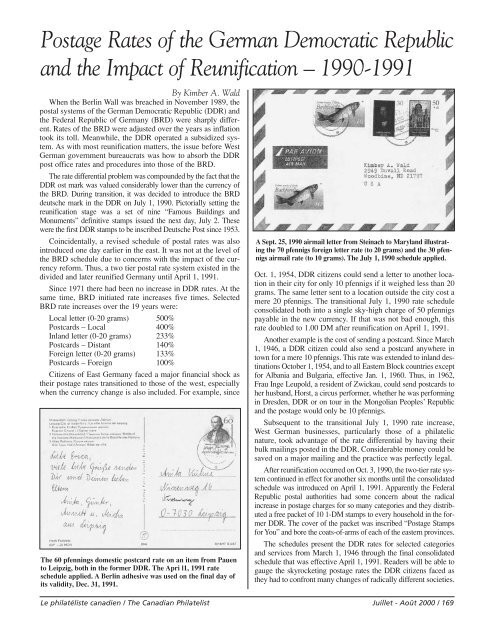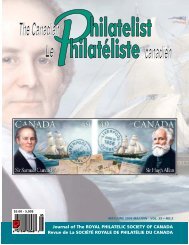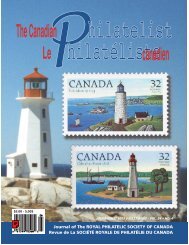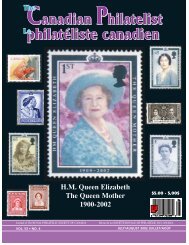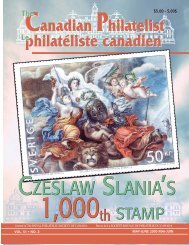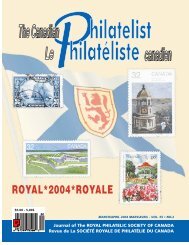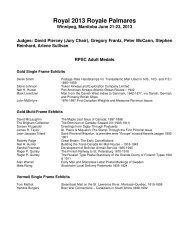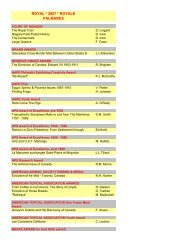Phil pages July-Aug-Final - The Royal Philatelic Society of Canada
Phil pages July-Aug-Final - The Royal Philatelic Society of Canada
Phil pages July-Aug-Final - The Royal Philatelic Society of Canada
You also want an ePaper? Increase the reach of your titles
YUMPU automatically turns print PDFs into web optimized ePapers that Google loves.
Postage Rates <strong>of</strong> the German Democratic Republic<br />
and the Impact <strong>of</strong> Reunification – 1990-1991<br />
By Kimber A. Wald<br />
When the Berlin Wall was breached in November 1989, the<br />
postal systems <strong>of</strong> the German Democratic Republic (DDR) and<br />
the Federal Republic <strong>of</strong> Germany (BRD) were sharply different.<br />
Rates <strong>of</strong> the BRD were adjusted over the years as inflation<br />
took its toll. Meanwhile, the DDR operated a subsidized system.<br />
As with most reunification matters, the issue before West<br />
German government bureaucrats was how to absorb the DDR<br />
post <strong>of</strong>fice rates and procedures into those <strong>of</strong> the BRD.<br />
<strong>The</strong> rate differential problem was compounded by the fact that the<br />
DDR ost mark was valued considerably lower than the currency <strong>of</strong><br />
the BRD. During transition, it was decided to introduce the BRD<br />
deutsche mark in the DDR on <strong>July</strong> 1, 1990. Pictorially setting the<br />
reunification stage was a set <strong>of</strong> nine “Famous Buildings and<br />
Monuments” definitive stamps issued the next day, <strong>July</strong> 2. <strong>The</strong>se<br />
were the first DDR stamps to be inscribed Deutsche Post since 1953.<br />
Coincidentally, a revised schedule <strong>of</strong> postal rates was also<br />
introduced one day earlier in the east. It was not at the level <strong>of</strong><br />
the BRD schedule due to concerns with the impact <strong>of</strong> the currency<br />
reform. Thus, a two tier postal rate system existed in the<br />
divided and later reunified Germany until April 1, 1991.<br />
Since 1971 there had been no increase in DDR rates. At the<br />
same time, BRD initiated rate increases five times. Selected<br />
BRD rate increases over the 19 years were:<br />
Local letter (0-20 grams) 500%<br />
Postcards – Local 400%<br />
Inland letter (0-20 grams) 233%<br />
Postcards – Distant 140%<br />
Foreign letter (0-20 grams) 133%<br />
Postcards – Foreign 100%<br />
Citizens <strong>of</strong> East Germany faced a major financial shock as<br />
their postage rates transitioned to those <strong>of</strong> the west, especially<br />
when the currency change is also included. For example, since<br />
<strong>The</strong> 60 pfennings domestic postcard rate on an item from Pauen<br />
to Leipzig, both in the former DDR. <strong>The</strong> Apri l1, 1991 rate<br />
schedule applied. A Berlin adhesive was used on the final day <strong>of</strong><br />
its validity, Dec. 31, 1991.<br />
A Sept. 25, 1990 airmail letter from Steinach to Maryland illustrating<br />
the 70 pfennigs foreign letter rate (to 20 grams) and the 30 pfennigs<br />
airmail rate (to 10 grams). <strong>The</strong> <strong>July</strong> 1, 1990 schedule applied.<br />
Oct. 1, 1954, DDR citizens could send a letter to another location<br />
in their city for only 10 pfennigs if it weighed less than 20<br />
grams. <strong>The</strong> same letter sent to a location outside the city cost a<br />
mere 20 pfennigs. <strong>The</strong> transitional <strong>July</strong> 1, 1990 rate schedule<br />
consolidated both into a single sky-high charge <strong>of</strong> 50 pfennigs<br />
payable in the new currency. If that was not bad enough, this<br />
rate doubled to 1.00 DM after reunification on April 1, 1991.<br />
Another example is the cost <strong>of</strong> sending a postcard. Since March<br />
1, 1946, a DDR citizen could also send a postcard anywhere in<br />
town for a mere 10 pfennigs. This rate was extended to inland destinations<br />
October 1, 1954, and to all Eastern Block countries except<br />
for Albania and Bulgaria, effective Jan. 1, 1960. Thus, in 1962,<br />
Frau Inge Leupold, a resident <strong>of</strong> Zwickau, could send postcards to<br />
her husband, Horst, a circus performer, whether he was performing<br />
in Dresden, DDR or on tour in the Mongolian Peoples’ Republic<br />
and the postage would only be 10 pfennigs.<br />
Subsequent to the transitional <strong>July</strong> 1, 1990 rate increase,<br />
West German businesses, particularly those <strong>of</strong> a philatelic<br />
nature, took advantage <strong>of</strong> the rate differential by having their<br />
bulk mailings posted in the DDR. Considerable money could be<br />
saved on a major mailing and the practice was perfectly legal.<br />
After reunification occurred on Oct. 3, 1990, the two-tier rate system<br />
continued in effect for another six months until the consolidated<br />
schedule was introduced on April 1, 1991. Apparently the Federal<br />
Republic postal authorities had some concern about the radical<br />
increase in postage charges for so many categories and they distributed<br />
a free packet <strong>of</strong> 10 1-DM stamps to every household in the former<br />
DDR. <strong>The</strong> cover <strong>of</strong> the packet was inscribed “Postage Stamps<br />
for You” and bore the coats-<strong>of</strong>-arms <strong>of</strong> each <strong>of</strong> the eastern provinces.<br />
<strong>The</strong> schedules present the DDR rates for selected categories<br />
and services from March 1, 1946 through the final consolidated<br />
schedule that was effective April 1, 1991. Readers will be able to<br />
gauge the skyrocketing postage rates the DDR citizens faced as<br />
they had to confront many changes <strong>of</strong> radically different societies.<br />
Le philatéliste canadien / <strong>The</strong> Canadian <strong>Phil</strong>atelist Juillet - Août 2000 / 169


